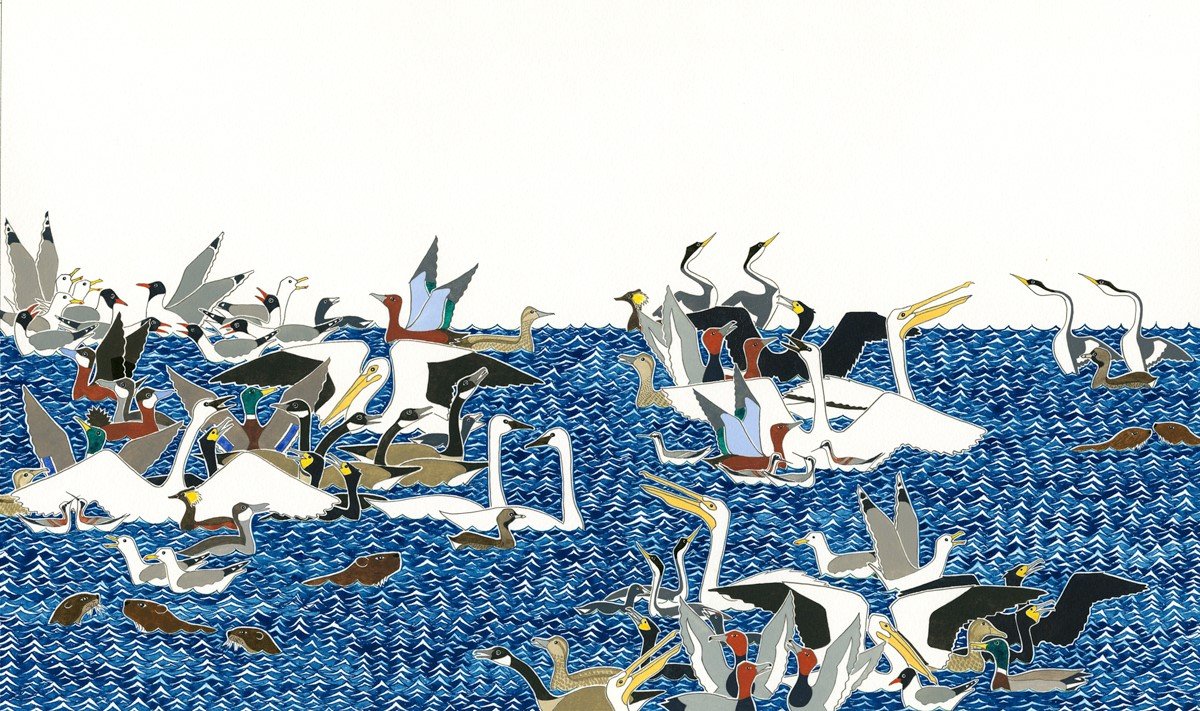From a very young age, illustrator Paul Goble delighted in the study of birds. During his childhood in England, he collected feathers, maintained a scrapbook of bird imagery and even rehabilitated an injured tawny owl. This early interest manifested into a lifelong passion for the study, care and depiction of birds. Birds were a favored subject matter in the illustrations Goble created for his retellings of Plains American Indian stories.
Goble often employed birds to ornament his bare skies and as a tool to direct the reader’s eye with their wings and flight patterns. His books feature a wide variety of birds, including the Western Grebe, American White Pelican, Great Blue Heron, Golden and Bald Eagles, Black-billed Magpie, among many others.
This exhibition includes nine Goble illustrations featuring birds as a central subject. Books they are drawn from include Beyond the Ridge, Crow Chief, Dream Wolf, The Gift of the Sacred Dog, Iktomi and the Buzzard, Iktomi and the Ducks and Remaking the Earth. These books are available for reference in the exhibition gallery and many are also available for purchase in the South Dakota Art Museum Store.
Author and illustrator Paul Goble was born in England on Sept. 27, 1933. He grew up in a family where art and literature were valued and promoted. He also grew up with a deep fascination for the indigenous peoples of North America. As a young man he made several visits to the United States to spend time in reservations in South Dakota and Montana. He moved to the Black Hills of South Dakota permanently in 1977 and became an American citizen in 1984.
Throughout his career, Goble garnered countless awards for his writing and artwork. In 1979 he received the Caldecott Medal, which is one of the most prestigious awards in all of children’s literature. Goble’s Caldecott winner, The Girl Who Loved Wild Horses, is just one of over 40 books in a career extending back to his first title, Red Hawk’s Account of Custer’s Last Battle, published in 1969. Throughout his long career, Goble focused on Plains American Indian history and retellings of traditional American Indian stories.
Goble recognized the issue of an Englishman recording the cultural heritage of American Indians. However, his intentions were clear when he stated, “The myths that I am retelling are not Tolkien-like stories to entertain, but are like Bible stories, parables, which hold real truths at different levels. They are a part of the Native American tradition, part of this land.” Award-winning Lakota author and illustrator S.D. Nelson says, “Paul Goble has a good heart. His paintings and his storytelling honor Lakota ways. Paul Goble, with his artistic insights, has shared our Lakota tradition and spiritual teachings with the world in a positive way. He is a true friend of our people.” Like Nelson, world-renowned Lakota flute player and hoop dancer, Kevin Locke, is an enrolled member of the Standing Rock Sioux Tribe. In a letter to Goble Locke once wrote, “You’ve done more to heighten an awareness of our culture than just about anyone I can think of.”
Paul Goble passed away on Jan. 5, 2017. The primary resource for access to works representative of his career is in Brookings at the South Dakota Art Museum. The museum’s extensive Paul Goble Collection consists of over 500 watercolor, gouache, and ink illustrations.











